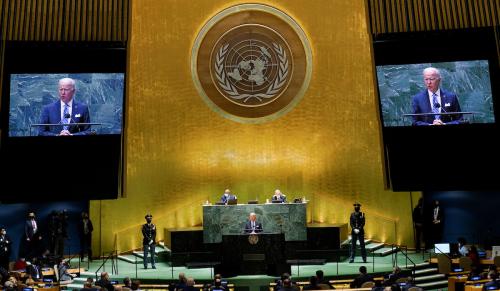The budget deal brokered by House Budget Chairman Paul Ryan (R-WI) and Senate Budget Chairman Patty Murray (D-WA) passed the House last week with bipartisan support, 332-94, and passed the Senate Wednesday, 64-36.
And so it is that 2013, a year that featured a seemingly endless succession of budget crises, will end on an upbeat note. Let’s briefly reflect on the many thrilling (i.e., seriously dispiriting) episodes from the past year and what they portend for 2014.
- As 2013 began, the first crisis to address was the so-called “fiscal cliff,” otherwise known as the impending expiration of the Bush era tax cuts. President Obama had won reelection promising to keep those tax cuts in place for all but the highest-earning Americans, and as a result the question was whether Republicans in the House would be willing to agree to any tax increases at all. In the end, the deal cut on January 1, 2013 kept tax rates constant for all those earning less than $400,000 (for individual filers) or $450,000 (for joint filers), allowing the marginal rate for top earners to revert to its 1990s level of 39.6%. The deal also failed to renew a two-year, 2% cut in the payroll tax begun in December 2010 and permanently “patched” the alternative minimum tax, meaning its applicability now remains limited without Congress having to restrict it each year. Little noted at the time: Congress waived its self-imposed Pay As You Go rule to enable the deal, which the CBO scored as adding nearly $4 trillion to the debt from 2013-2022 relative to previous law—though observers were always quick to note that nobody ever really thought keeping that trajectory was politically feasible. The Senate approved the compromise 89-8, and Speaker of the House John Boehner (R-OH) allowed it to win passage 257-167 in spite of lacking majority Republican support in his chamber.
- Unaddressed in that New Year’s deal was the statutory debt limit, in spite of the fact that on December 31, 2012, the Treasury ran up against the limit of $16.4 trillion. That meant that the Treasury would have to fund the government through “extraordinary measures” rather than issuing new debt, which was expected to enable things to go on as normal through February or March. Republicans decided to fight over other issues, though, and called a short-term truce by offering H.R. 325, the No Budget, No Pay Act of 2013 in late January. The easily-agreed to compromise said that both chambers would be required to pass budgets or have their members face the prospect of not getting their pay until the last day of the term. (Suspending pay entirely was the favored choice, but that ran into Constitutional difficulties.) Rather than raising the numerical debt limit, it suspended it until May 19, saying that the limit would automatically reset then to accommodate whatever spending had been incurred to that point. At that point, extraordinary measures would be used again, apparently providing wiggle room until October or November (thanks in part to huge payments to the Treasury by Fannie Mae and Freddie Mac expected over the summer).
- With taxes and the debt ceiling (at least temporarily) addressed, lawmakers had to decide how to fund the government before the impending expiration of the continuing resolutions on March 27. With just days to spare, they did so, agreeing to a new set of continuing resolutions that would fund the government through the end of September. Much to the chagrin of appropriators, the deal left in place the automatic budget cuts mandated by the 2011 budget deal (AKA “the sequester”), though it did provide agencies a bit of flexibility in adapting to potential cuts.
- The summer was mercifully budget-crisis-free, allowing the 113th Congress to go be historically unproductive in other areas. The main event of 2013 came in the autumn, when the continuing resolutions funding government were set to expire (at the end of September) and the Treasury’s extraordinary measures would run out, requiring a debt ceiling increase to avoid default (with the earliest possible crisis date pegged for October 17). This time, Republicans decided to press their political agenda into the budget process far more aggressively, and so they tied their willingness to fund the government to the requirement that all funding for the Affordable Care Act be withheld. Predictably, that was a political non-starter, and so negotiations stalled in late September. The federal government partially shut down for the first time since 1996 as a result. Meanwhile, the debt ceiling deadline approached, potentially bringing with it far more catastrophic troubles. Washington insiders who remained confident that something would be worked out in time had their faith tested as October 17 approached, but ultimately saw their predictions of an eleventh hour deal vindicated: a deal was passed and signed into law on October 16. The deal provided back-pay for federal workers affected by the shutdown, funded the government through January 15, 2014, and suspended the debt ceiling until February 7, 2014, as well as forming a bicameral conference committee to work through budget issues by December. FixGov drew many lessons from the shutdown, rounded up here.
- Finally, this week’s news: the bicameral conference committee seems to have succeeded in reaching a working compromise that will keep the government open for the next two years. The Ryan-Murray deal partially mitigates the sequester for 2014 and 2015, balancing these spending increases with various fee increases and small long-term cuts that will take effect down the road. Apparently (to the delight of some and the dismay of others), there was little effort to forge any kind of grand fiscal bargain. Still, in a year in which every needed agreement became a potential crisis, small-bore compromise feels like a major step in the right direction.
It would be far too soon, though, to imagine that our pattern of lurching from one fiscal crisis to the next is yet at an end. The debt ceiling will automatically be reached again on February 7, meaning that the Treasury will run out of available funds sometime early in the year—possibly as early as late February. I’ve argued many times (in a Brookings White Paper, in The Hill’s Congress Blog, and at National Review) by now that the debt ceiling is an anachronism unlikely to deliver the fiscal conservative results its (largely politically opportunistic) supporters hope for. But the “political optics,” as they say, make it risky for legislators to take the logical step of replacing the debt ceiling with something better, so unfortunately this crisis-generator may stay with us for some time.
Meanwhile, the country suffers continuing losses from the uncertainty created by the sequester, which makes government planning extremely difficult. And unfortunately, it is hard to imagine that 2014 will see the kind of serious political compromise that could deliver a more durable fiscal path forward.
But we need not end on such a gloomy note. After all, FixGov was only created late in 2013, too late to stop the budget madness of the past year. We’ll be on the scene for all of 2014, which should give us plenty of time to set things right…
Updated: The revised version notes the vote on Senate passage of the agreement.



Commentary
FixGov’s Review of 2013: Lurching from One Fiscal Battle to Another
December 18, 2013